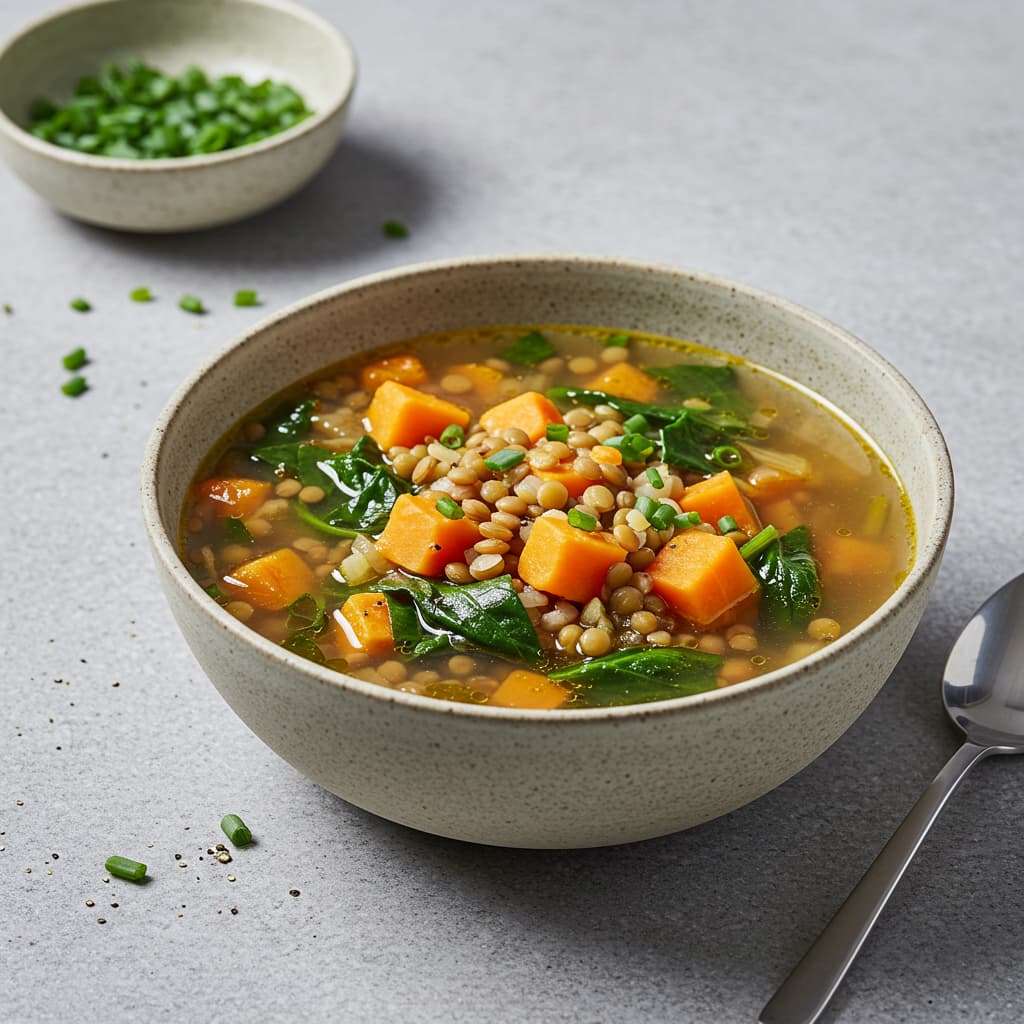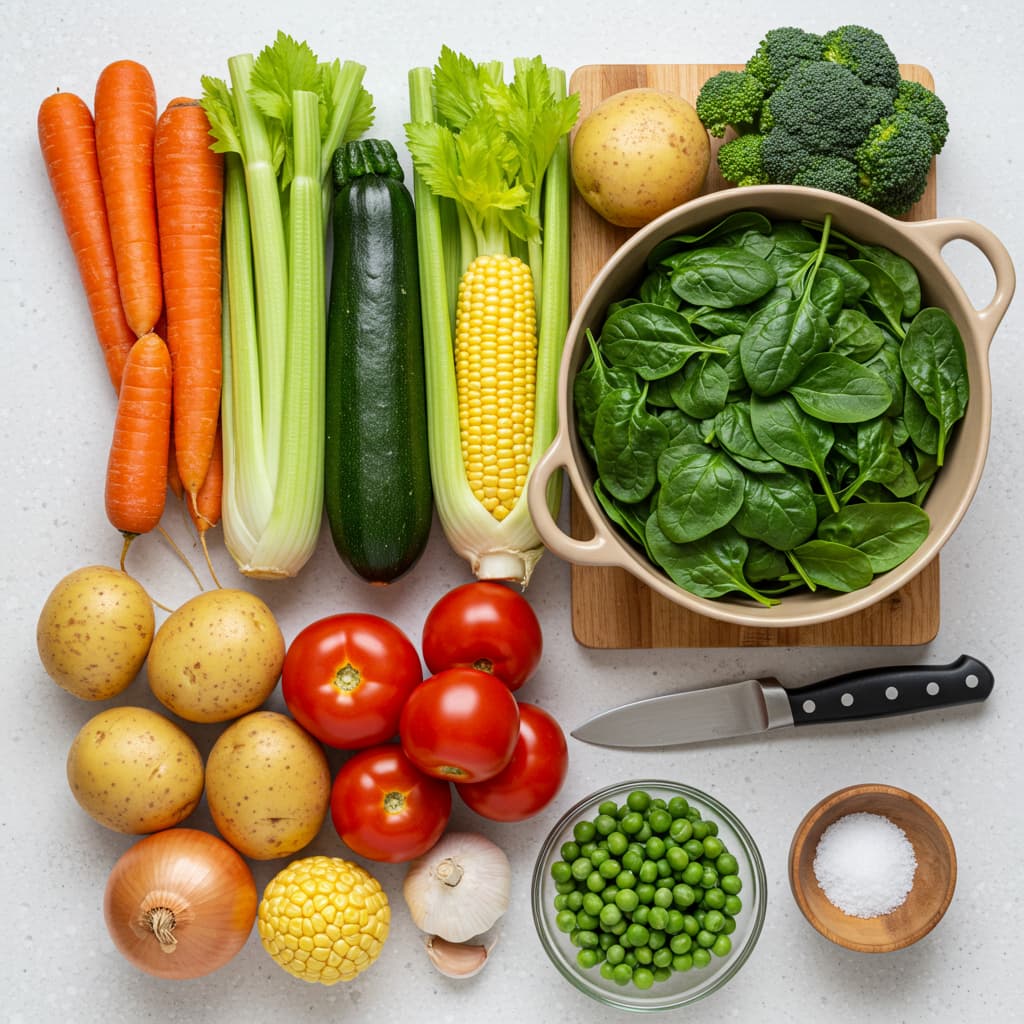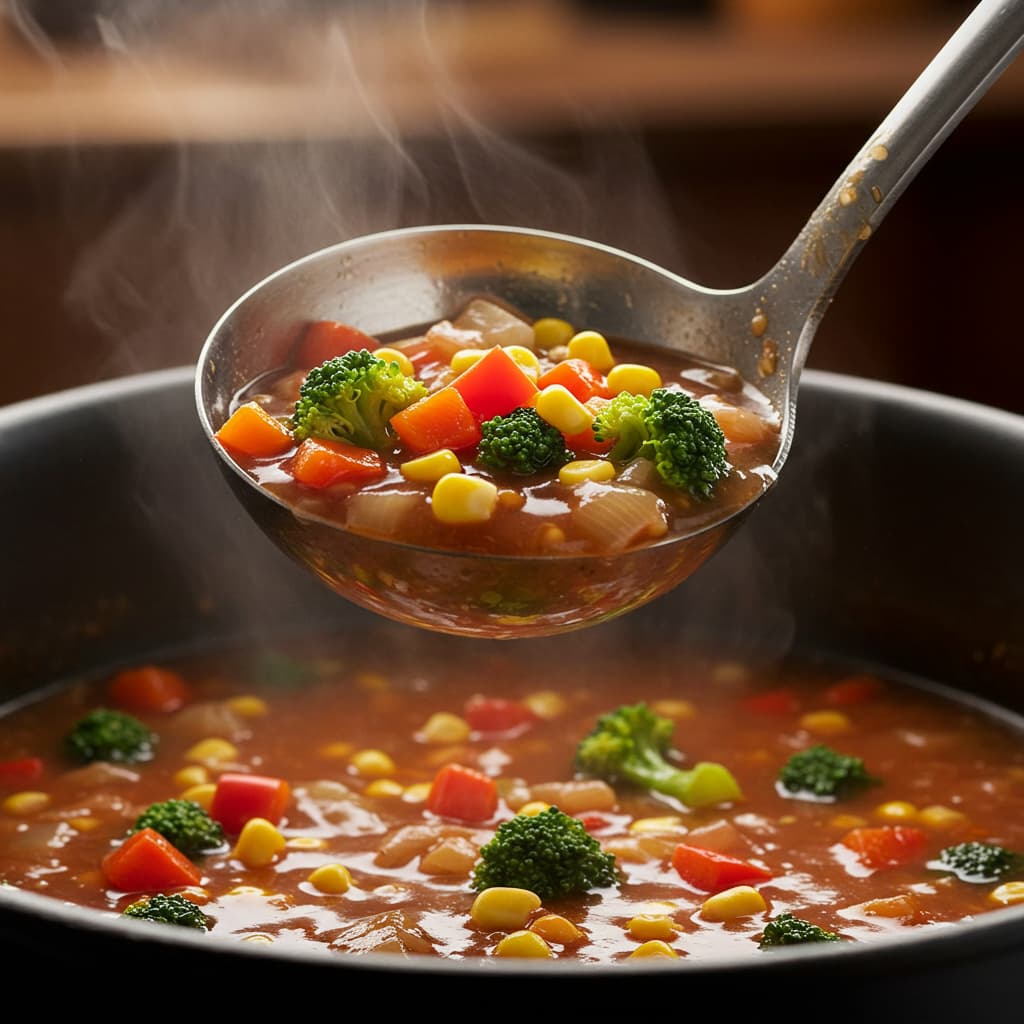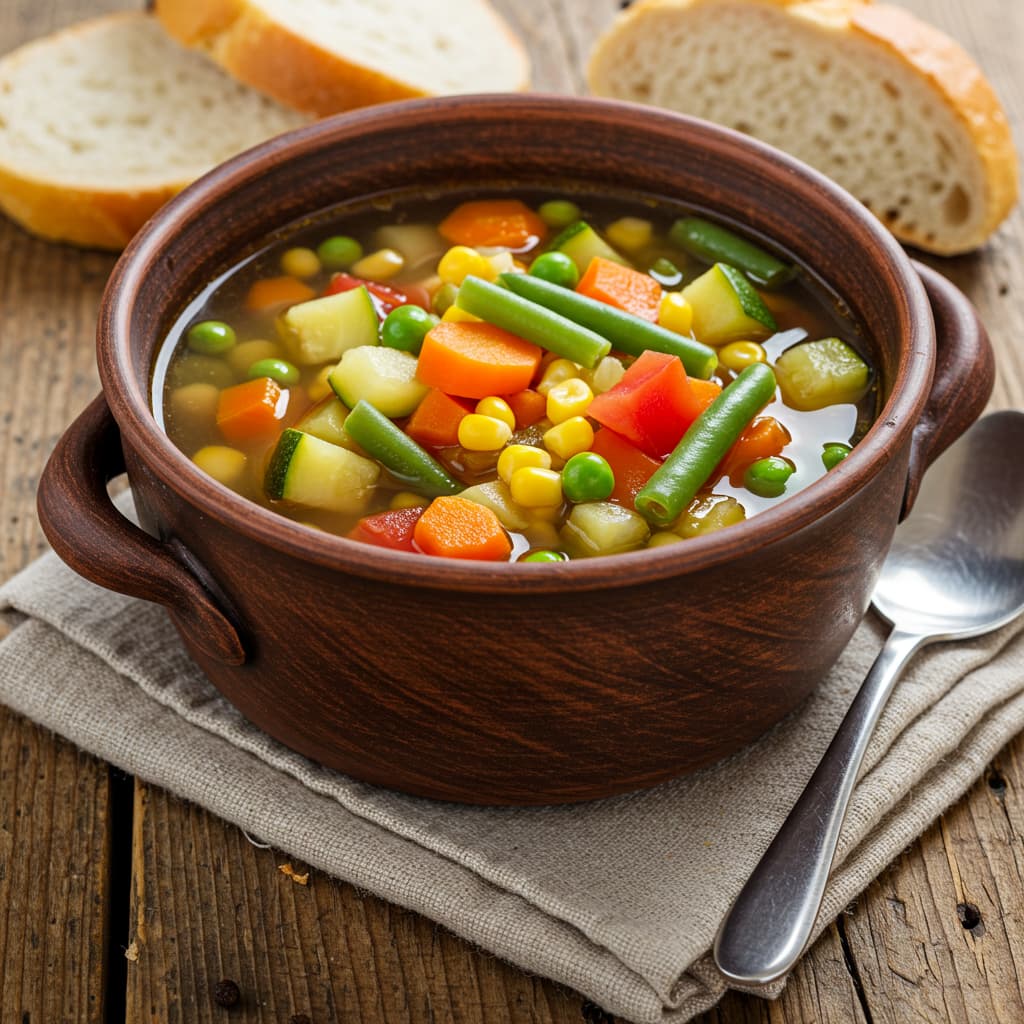Introduction
Tired of bland, watery vegetable soups that taste like boiled water with a few sad vegetables floating around? This perfect 10 Vegetable Soup recipe delivers a rich, flavorful broth packed with tender vegetables, vibrant colors, and satisfying nutrition that will make you forget you’re eating something incredibly healthy.
As a professional chef and nutrition enthusiast who’s spent over 12 years perfecting plant-based recipes, I’ve discovered that the secret to exceptional vegetable soup lies in layering flavors through proper sautéing techniques and understanding which vegetables to add when for optimal texture and taste. This isn’t just another boring health food – it’s a celebration of vegetables at their absolute best.
In this comprehensive guide, you’ll master the art of creating the perfect 10 Vegetable Soup through strategic vegetable selection, proper preparation techniques, and flavor-building methods that transform simple ingredients into a restaurant-quality soup. I’ll share professional tips for achieving the ideal texture, make-ahead strategies, and creative variations that will make this your go-to recipe for healthy, satisfying meals.
Table of Contents

Why This Vegetable Recipe Works
The 10 Vegetable Soup has become a healthy cooking staple because it delivers on every level:
- Uses affordable, seasonal vegetables available at any grocery store year-round
- Takes just 20 minutes of prep time with simple chopping and sautéing
- Perfect for meal prep, weight loss goals, and feeding large families nutritiously
- Each vegetable contributes unique flavors and textures for complex taste
- Provides complete nutrition with fiber, vitamins, and antioxidants in every bowl
- Freezes beautifully for up to 6 months, making it ideal for batch cooking
Choosing the Right Vegetables
The Perfect 10 Vegetable Combination
The ideal 10 Vegetable Soup combines vegetables with different cooking times, flavors, and nutritional profiles. Root vegetables like carrots and potatoes provide body and natural sweetness. Aromatic vegetables like onions and celery create the flavor base. Leafy greens such as kale or spinach are excellent additions for boosting both color and nutritional value. Each vegetable serves a specific purpose in creating the perfect balanced soup.
Seasonal Selection and Quality Tips
For the freshest flavor and best value, always choose vegetables that are currently in season in your country. Look for firm root vegetables without soft spots, bright-colored bell peppers with taut skin, and leafy greens that aren’t wilted or yellowing. Fresh herbs make a significant difference – avoid dried herbs if possible and opt for fresh parsley, thyme, or basil for the finishing touch.
Smart Vegetable Substitutions
The beauty of 10 Vegetable Soup lies in its flexibility. Swap butternut squash for sweet potatoes, use leeks instead of onions, or substitute Swiss chard for kale based on availability and preference. Frozen corn, peas, and green beans are excellent choices for this recipe, offering convenience without compromising quality. Root vegetables can be interchanged freely – parsnips, turnips, and rutabagas all work beautifully.
Ingredients & Prep
Essential Vegetable Preparation
Proper knife work is essential for both even cooking and a professional presentation. Dice root vegetables like carrots, potatoes, and parsnips into ½-inch (1.25 cm) pieces to ensure they cook uniformly. Slice celery on the bias – meaning at an angle – for an appealing visual touch. Chop onions uniformly to ensure they cook evenly. Leafy greens should be roughly chopped and stems removed for the best texture.
Aromatic Base Building
Create a flavor foundation by sautéing the “mirepoix” – onions, carrots, and celery – in olive oil until softened and fragrant. This technique, called “sweating,” releases the vegetables’ natural sugars and creates depth of flavor that distinguishes restaurant-quality soups from home cooking. Patience is key here, as this step is crucial for developing rich, complex flavors.

Pantry Staples and Seasonings
High-quality vegetable broth forms the soup’s backbone – use low-sodium versions to control salt levels. The essential seasonings for this dish include bay leaves, fresh thyme, black pepper, and sea salt. Tomato paste provides umami depth, while fresh lemon juice brightens the finished soup.
Step-by-Step Cooking Instructions
Pre-Cooking Preparation
Wash and prep all vegetables before you begin cooking – this ensures smooth execution once you start. Organize vegetables by cooking time: aromatics first (onions, garlic), then hard vegetables (carrots, potatoes), followed by medium vegetables (zucchini, bell peppers), and finally quick-cooking vegetables (leafy greens, fresh herbs).
Building the Flavor Base
Heat 2 tablespoons of olive oil in a large, heavy-bottomed pot over medium heat. Add the diced onions, carrots, and celery, cooking for 8 to 10 minutes until they’re softened and lightly caramelized. Stir in the minced garlic and cook for just one more minute until it becomes fragrant. This aromatic base, known as soffritto in Italian cooking, provides the flavor foundation for your soup.
Layered Vegetable Addition
Add vegetables in order of cooking time. Start by adding root vegetables such as potatoes and parsnips, cooking them for 5 minutes. Next, stir in the tomato paste and cook for 2 minutes to develop a rich, deep flavor. Finally, pour in the vegetable broth and bring the mixture to a boil. Add medium-cooking vegetables like bell peppers and zucchini, then simmer for 15-20 minutes until all vegetables are tender but still hold their shape.
Final Seasoning and Finishing
During the last 5 minutes, add quick-cooking vegetables like leafy greens, corn, and peas. Season with salt, pepper, and fresh herbs. Taste and adjust seasoning – the soup should be well-balanced with no single vegetable dominating. A squeeze of fresh lemon juice brightens all the flavors and adds the perfect finishing touch.
Pro Tips for Perfect 10 Vegetable Soup
Achieving Optimal Texture and Color
Cut vegetables uniformly for even cooking and professional appearance. Don’t overcook – vegetables should be tender but still maintain their individual textures and colors. Add delicate vegetables like zucchini and leafy greens at the end to preserve their vibrant colors and prevent mushiness.
Essential Tool Recommendations
A large, heavy-bottomed Dutch oven or soup pot ensures even heat distribution and prevents scorching. A sharp knife is your best tool for faster and safer prep work in any kitchen A wooden spoon won’t scratch your pot and is perfect for stirring. An immersion blender allows you to partially puree the soup for varied texture if desired.
Storage and Reheating Excellence
10 Vegetable Soup improves in flavor after a day as the vegetables meld together. You can store this soup in the refrigerator for up to 5 days, or freeze it in individual portions for up to 6 months. When it’s time to reheat, do so gently over medium heat to ensure the vegetables don’t overcook. You may need to add extra broth as the soup thickens when cooled.
Flavor Variations
International Flavor Profiles
Transform your 10 Vegetable Soup with global seasonings. For Mediterranean flair, add Italian herbs like basil and oregano, along with a Parmesan rind, to the soup. To create a Mexican-inspired version, incorporate cumin, smoked paprika, and a touch of lime. For Asian-inspired soup, use ginger, soy sauce, and finish with sesame oil and scallions.
Dietary Adaptations
For heartier soup, add cooked beans, lentils, or quinoa for protein. Keto dieters can focus on low-carb vegetables like cauliflower, broccoli, and leafy greens while omitting potatoes and corn. Paleo versions work beautifully as written, using bone broth instead of vegetable broth for added nutrients.
Seasonal and Creative Twists
Summer versions can feature fresh tomatoes, corn, and basil for a garden-fresh taste. As the cooler months approach (even in Fes!), fall soups truly shine with ingredients like winter squash, sweet potatoes, and comforting spices such as nutmeg. Spring variations showcase asparagus, peas, and fresh herbs. Add coconut milk for creaminess without dairy, or stir in pesto for an herbal boost.

Serving Suggestions
Complementary Accompaniments
Serve your 10 Vegetable Soup with crusty artisan bread or homemade cornbread for a complete meal. A dollop of Greek yogurt or sour cream adds richness and creaminess. Grated Parmesan cheese melts wonderfully, adding a rich finish to the hot soup. A simple green salad with vinaigrette provides textural contrast and additional nutrients.
Creative Serving Ideas
Transform the soup into a hearty stew by pureeing half the vegetables for a thicker consistency. Serve over cooked grains like brown rice or quinoa for a filling meal. Use as a base for other recipes – add cooked pasta for minestrone or blend completely for a smooth vegetable bisque.
Beverage Pairings
Herbal teas like chamomile or green tea make excellent non-alcoholic pairings that won’t compete with the soup’s natural flavors.
FAQs
Can I use frozen vegetables for this recipe?
Yes! Frozen vegetables work excellently for 10 Vegetable Soup. Add them directly to the pot without thawing – they’ll cook perfectly in the hot broth. Frozen corn, peas, and green beans are excellent choices for this recipe. Just keep in mind that frozen vegetables might cook a little faster than fresh ones, so adjust your timing accordingly.
How can I ensure my vegetables stay crisp-tender and don’t get overcooked?
The key is proper timing and temperature control. Add vegetables in order of cooking time, maintain a gentle simmer rather than a rolling boil, and don’t overcook. Each vegetable should be tender but still hold its shape. Taste-test vegetables as they cook to achieve the perfect texture.
Can I adapt this recipe for a slow cooker?
Absolutely! Sauté the aromatic vegetables (onions, carrots, celery) in a pan first for best flavor, then transfer to your slow cooker with remaining ingredients. For slow cooking, choose low for 6 to 8 hours or high for 3 to 4 hours. Add delicate vegetables like leafy greens during the last 30 minutes to prevent overcooking.
Why does my vegetable soup taste bland?
Bland soup usually results from insufficient seasoning or skipping the sautéing step. Always build your flavor base by cooking the aromatic vegetables first. Season your dish as you go, rather than waiting until the very end. Use quality vegetable broth and don’t forget the finishing touches like fresh herbs and lemon juice.
Conclusion
Master this perfect 10 Vegetable Soup recipe and you’ll have a nutritious, satisfying meal that proves healthy eating doesn’t mean sacrificing flavor. This versatile soup works for weight loss goals, meal prep success, and feeding families wholesome, delicious food that everyone will actually want to eat.
Join thousands of home cooks who’ve discovered that the secret to exceptional vegetable soup lies in proper technique, quality ingredients, and understanding how to layer flavors for maximum impact. Once you master these fundamentals, you’ll never settle for bland vegetable soup again.



